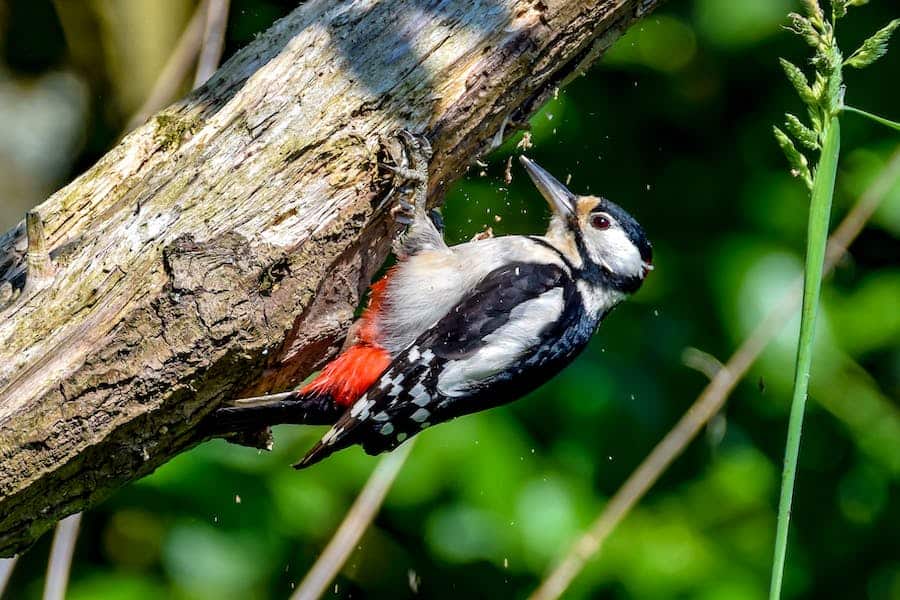
Woodpeckers, with their striking plumage and unmistakable drumming, are fascinating creatures that have captured the curiosity of nature enthusiasts for generations. While these charismatic birds are often celebrated for their unique behaviors, a common question lingers: do woodpeckers harm the trees they peck on? In this article, we delve into the intricate relationship between woodpeckers and trees, aiming to address the age-old query of whether woodpeckers can kill trees. By exploring their feeding habits, the signs of woodpecker activity, and scientific research, we’ll uncover the truth about woodpeckers’ impact on our arboreal friends and learn how to foster harmonious coexistence with these captivating avian neighbors.
Do Woodpeckers Kill Trees?
Woodpeckers generally do not kill healthy trees. Their characteristic drumming and pecking are primarily focused on finding insects, larvae, and other arthropods beneath the bark, which can help trees by controlling pest populations. However, in rare cases, excessive woodpecker activity can harm weakened or stressed trees. So, while woodpeckers are not tree killers, it’s vital to monitor tree health and address any issues to ensure a harmonious coexistence with these fascinating birds.
Woodpecker And Tree Interaction
The interaction between woodpeckers and trees is a fascinating and intricate aspect of nature. Woodpeckers are known for their distinctive pecking and drumming behaviors on tree trunks, but this interaction goes beyond mere curiosity or entertainment. It plays a significant role in the woodpeckers’ survival and the trees’ health. Here, we’ll explore this interaction in more detail:
- Feeding Habits: Woodpeckers do not randomly peck at trees but actively search for food. Their primary diet consists of insects, larvae, and arthropods that dwell beneath the bark of trees. By drumming and pecking, woodpeckers can detect the movements and sounds of these hidden creatures, making them formidable predators of tree-dwelling pests.
- Tree Health: Surprisingly, woodpeckers can be beneficial to tree health. By foraging for insects, they help control pest populations that could otherwise harm the tree. This natural pest control service contributes to the overall well-being of trees in forests and woodlands.
- Signs of Woodpecker Activity: Woodpecker activity on trees can be recognized by distinctive visual and auditory cues. The most evident sign is the holes they create in the tree’s bark. These holes are typically evenly spaced and serve as access points to the insects beneath the surface. The resonating drumming sounds are often part of woodpecker communication and territory marking.
- Potential Tree Damage: While woodpeckers generally benefit trees, there are situations where their activity might pose a problem. If a tree is already weakened due to disease, stress, or drought, excessive woodpecker activity can exacerbate its decline. In such cases, addressing the underlying issues affecting the tree’s health is essential.
Understanding the dynamic interaction between woodpeckers and trees highlights the intricate balance of nature. Woodpeckers play a crucial role in maintaining the health of forests and woodlands by controlling insect populations. While they may occasionally contribute to tree damage in specific circumstances, their overall impact on trees is generally positive, making them valuable contributors to ecosystems.
Studies On The Effects Of Woodpecker Feeding On Trees
Studies on the effects of woodpeckers feeding on trees have provided valuable insights into the relationship between these birds and their arboreal surroundings. Researchers have conducted numerous investigations to understand how woodpecker activity influences tree health and ecosystem dynamics. Here are some key findings and studies in this field:
- Insect Control: One of the primary benefits of woodpeckers feeding on trees is insect control. Studies have shown that woodpeckers play a crucial role in reducing populations of tree-damaging insects and their larvae. For example, a study published in the journal “Ecology” (1979) by Smith and Leopold found that woodpecker predation significantly reduced the abundance of the European elm bark beetle, known to transmit Dutch elm disease.
- Bark Beetle Control: Woodpeckers are particularly effective at controlling bark beetles, which can devastate trees. Research conducted by the U.S. Forest Service has demonstrated the impact of woodpeckers in reducing the spread of bark beetle infestations, ultimately helping to protect trees from damage.
- Tree Species Variation: Studies have also highlighted variations in the impact of woodpecker feeding on different tree species. Some trees, such as pine trees, may be more susceptible to woodpecker activity due to the presence of wood-boring insects. Conversely, hardwood trees with thicker bark may be less affected.
- Tree Health and Stress: Research has indicated that woodpeckers are more likely to target already stressed or compromised trees. A study published in “The Auk” (1994) by Jackson and Jackson suggested that woodpeckers preferentially selected trees with fungal infections, which may make the tree more vulnerable to further damage.
- Ecosystem Dynamics: Woodpeckers are keystone species in many ecosystems, and their feeding habits can affect the entire ecosystem. By controlling insect populations and creating nesting cavities that benefit other wildlife, woodpeckers contribute to the overall health and biodiversity of forests.
Collectively, these studies underscore the importance of woodpeckers in maintaining ecological balance and tree health. While their feeding behavior may occasionally cause localized damage to trees, the overall ecological benefits they provide, including natural pest control, outweigh any negative impacts. Understanding the dynamics of woodpecker-tree interactions can inform conservation efforts and forest management practices to promote healthy ecosystems.
Trees That Are More Susceptible To Woodpecker Damage
Certain tree species are more susceptible to woodpecker damage due to various factors such as bark characteristics, insect infestations, and the availability of wood-boring insects. Here are some tree species that are more likely to experience woodpecker activity:
Pine Trees: Pine trees are frequently targeted by woodpeckers, particularly when infested with bark beetles. These beetles burrow into the tree’s inner layers, emitting vibrations and sounds that attract woodpeckers. The resonance created by pecking against the pine’s hard, resinous bark makes it easier for woodpeckers to detect and extract the insects. As a result, pine trees with bark beetle infestations are highly vulnerable to woodpecker damage.
Spruce Trees: Like pine trees, they are often sought out by woodpeckers when they harbor bark beetle infestations. The thin and flaky bark of spruce trees provides woodpeckers with relatively easy access to the insects beneath. Woodpeckers’ resonating drumming sounds help them locate and extract the wood-boring pests.
Cedar Trees: Cedars, with their soft, peeling bark, can also be susceptible to woodpecker activity. When infested with wood-boring insects, such as cedar bark beetles, these trees become attractive to woodpeckers. The peeling bark allows woodpeckers to access the insects more easily.
Fruit Trees: Fruit-bearing trees like apple, cherry, and pear trees may draw woodpeckers searching for insects. Woodpeckers are opportunistic feeders, and they may probe the bark of these trees if they detect signs of insect infestations. Rotting fruit and the presence of borers can make these trees especially attractive to woodpeckers.
Deciduous Trees with Loose Bark: Certain deciduous trees, including birches and poplars, have bark that can easily peel away from the trunk or branches. Woodpeckers may exploit this feature to access insects hidden beneath the bark. The loose bark provides an entry point for the birds to forage for food.
Trees with Existing Damage: Trees already weakened due to disease, drought, or other environmental stressors are more likely to be targeted by woodpeckers. Woodpeckers prefer easier trees to forage on, and compromised trees fit the bill. The sound of wood-boring insects within these weakened trees may attract woodpeckers seeking a meal.
Old or Dead Trees (Snags): Dead or dying trees, commonly referred to as snags, are essential habitat for woodpeckers. Woodpeckers create cavities in these trees for nesting and shelter. While this behavior doesn’t necessarily kill the trees, it can accelerate their natural decay. This process, however, benefits other wildlife that rely on the cavities created by woodpeckers.
Trees That Are Less Vulnerable
Certain tree species are less vulnerable to woodpecker damage due to their bark characteristics, resistance to insect infestations, and overall health. These trees are less likely to be targeted by woodpeckers for feeding or nesting. Here are some tree species that are typically less susceptible to woodpecker activity:
Oak Trees:
Oak trees are renowned for their sturdy and thick bark, a natural deterrent for woodpeckers. This robust bark makes it challenging for woodpeckers to penetrate and access the insects beneath the surface. Furthermore, oak trees are generally less prone to insect infestations, reducing their attractiveness to these birds.
Hickory Trees:
Hickory trees boast complex and textured bark, which is less appealing to woodpeckers. This bark texture and hickory’s resistance to wood-boring insects make it an unattractive target for woodpecker feeding.
Maple Trees:
Maple trees, especially those with smooth bark, are not commonly targeted by woodpeckers. Their bark lacks the loose, flaky texture that facilitates woodpecker foraging. Additionally, maple trees are typically less susceptible to insect pests.
Beech Trees:
Beech trees feature smooth, gray bark that does not provide easy access for woodpeckers. While woodpeckers may occasionally visit beech trees, they are generally less vulnerable than other species with more favorable bark characteristics.
Pecan Trees:
Pecan trees possess thick and deeply furrowed bark, making it difficult for woodpeckers to access insects hiding beneath the surface. Moreover, pecan trees are less likely to host wood-boring insects, decreasing their attractiveness to these birds.
Hardwood Trees:
In a broader sense, hardwood trees with dense, sturdy bark are generally less susceptible to woodpecker damage. Species such as walnut, cherry, and ash fall into this category, and their bark texture provides a protective barrier against woodpecker foraging.
Healthy Trees:
Trees that are in good health and well-maintained are less likely to attract woodpeckers. Woodpeckers often target trees that are already weakened or stressed, as these may indicate the presence of insects. Regular tree care and maintenance can help ensure tree health and reduce the risk of woodpecker activity.
Conifers with Resinous Bark:
Certain conifers, like cedar and redwood, have thick and resinous bark, posing a challenge for woodpeckers to access wood-boring insects. This factor, combined with their natural resistance to pests, makes them less susceptible to woodpecker activity.
Bottom Line
In conclusion, woodpeckers do not typically kill healthy trees. Their pecking behavior primarily aims to find insects and larvae hidden beneath the bark, which can benefit trees by controlling pest populations. However, excessive woodpecker activity can exacerbate their decline in certain circumstances, such as drought or when trees are already weakened. Therefore, it’s essential to strike a balance between appreciating these intriguing birds and safeguarding the well-being of our trees, fostering a coexistence that benefits both woodpeckers and our precious arboreal ecosystems.
FAQ’s
Q. How Can I Protect My Trees from Woodpecker Damage?
To protect your trees, address underlying issues that may attract woodpeckers, such as insect infestations or tree stress. You can create alternative woodpecker feeding areas or use deterrent methods like reflective tape or scare devices.
Q. Do Woodpeckers Serve Any Positive Purpose for Trees?
Yes, woodpeckers are valuable in controlling insect populations that can harm trees. They help maintain the ecological balance of forests by reducing the number of wood-boring insects and other pests.
Q. Can Woodpecker Activity Be Harmful to Trees Under Certain Conditions?
Woodpecker activity is generally not harmful to healthy trees. However, if a tree is already weakened due to disease, drought, or other factors, excessive woodpecker activity can contribute to its decline. In such cases, addressing the underlying issues affecting the tree’s health is crucial.








